Mario Kart 64
Released: December 14, 1996
Mario Kart 64 is a racing video game for the Nintendo 64 game system; it can utilize up to four human controlled players in some modes of play. It is the sequel to Super Mario Kart for the SNES . While being developed, it was known as Super Mario Kart R. Players take control of characters from the Super Mario Bros. video game series by racing around a variety of tracks while using several weapons; including items that make the racers' speed increase, shoot turtle-shell projectiles, and drop or throw slippery banana peels. The game was developed and published by Nintendo and released on December 14 , 1996 in Japan, and on February 10 , 1997 in North America. Music for the game was composed by Koji Kondo , who has also composed scores for many Nintendo games, and Kenta Nagata.
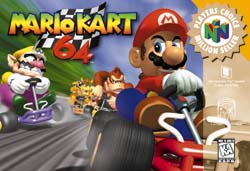
Mario Kart 64 features a number of changes from Super Mario Kart .
- The game now features a fullscreen view in single-player mode, as opposed to the split-screen view found in Super Mario Kart. There are now two different types of HUD maps that can be used to compensate for the loss of the map on the lower split screen.
- Each track now requires three laps instead of five (but the track lengths have been altered so that they range from slightly longer to much longer).
- Tracks now have hills, slopes, bumps and jumps.
- Tracks are no longer reincarnations of each other, like Mario Circuit 1, Mario Circuit 2, Mario Circuit 3, Mario Circuit 4 etc. Each track has its own unique location.
- Koopa Troopa and Donkey Kong Junior have been replaced by Wario and Donkey Kong .
- Coins have been removed, so the player does not spin out unless he/she crashes into a heavier opponent or turns too dramatically.
- The feather item, which allowed the kart to jump, was removed.
- Several items were added, such as Golden Mushrooms, Fake Item Boxes, and Spiny (Blue) Shells. Items could also be bunched into groups to heighten a player's advantage, including the Green and Red Shells (three), Mushrooms (three), and Banana Peels (five).
- Item boxes reset themselves after being hit, making them available to players on every lap.
- Item boxes can be found on more than one area on the track on every circuit.
- Mushrooms no longer appear in battle mode, and a player now starts with 3 in time trial mode, rather than none, like in Super Mario Kart .
- Computer-controlled racers are no longer exclusive to their own infinite disposal of an item. However, they are still limited to using only certain items. In short, they can use any item except for any kind of shell.
- It is now possible to drift by hopping and tilting the control stick. If the control stick is moved left and right while the kart is drifting, it is possible to gain a small boost in speed, called a Mini-Turbo. The Mini-Turbo was subsequently included in every Mario Kart game, as was drifting (but it was different in Mario Kart Super Circuit , in which any character that drifts for a 90 degree circular rotation, then drives straight for a few seconds, gets a boost). In Mario Kart terminology, this process of drifting is sometimes referred to as a power slide .
- Skilled players are known to continuously drift throughout the course, exploiting Mini-Turbo boosts even on straightways. In Mario Kart terminology, chaining Mini-Turbo boosts together in a straightaway is referred to as Snaking, since the path of the player is much like the movement of a snake.
- Unlike in Super Mario Kart for the SNES , there is no limit on lives in Grand Prix. If the player fails to pass a certain level with a rank of 4th or better, the player can still retry the course as many times as he or she wants.
- In Super Mario Kart , one had to get a gold trophy in each cup on 100 cc of GP Mode in order to unlock the Special Cup. In this version, the Special Cup is available immediately.
- Mario Kart 64 is the first title to include a Mirror Mode, in which the tracks are mirrored (Later used in Double Dash and Mario Kart DS ).
- Wii's Virtual Console sees a release of this in January 2007, costing 1000 Wii points.
Modes of gameplay
Mario Grand Prix (GP)
One to two human players compete with computer players in a group of eight around a series of four courses per cup. A player selects one of the four cups at the beginning of the game as well as a difficulty level, measured by engine size (50, 100 or 150 cc). The higher the engine size, the faster the karts go and the more difficult the cup is. Extra Mode (where the courses are mirror images of normal) can also be unlocked by winning of all four cups on 150cc difficulty. A player needs to place in fourth place or better in order to move on to the next track.
Time Trials
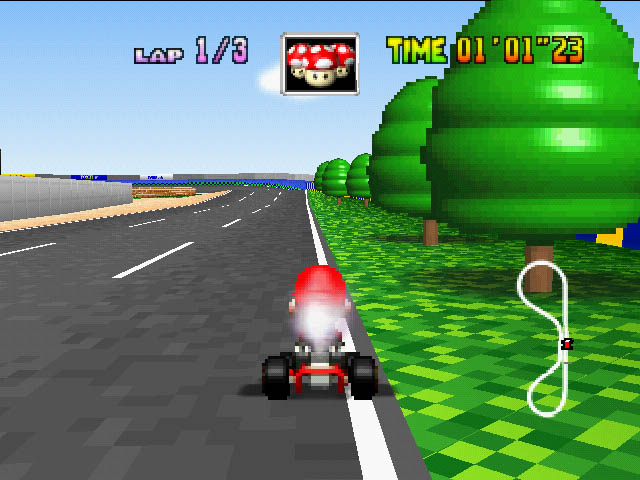
This is a single-player mode. A player may play any course in any cup. In time trial, the player is given a triple mushroom item, and the kart has a 100cc engine. The top five best course times and the best lap time are recorded on the cartridge, and the aim is for the player to beat his or her own records. Completing a race may result in a ghost appearing on the player's next attempt.
A ghost is a transparent recording of the best race the player has done in the current session, and are used by players to race "against themselves". Ghosts can be saved onto a controller pak. Internally, a ghost is believed to be stored as a recording of button-presses that the player committed, and is replayed by using them as input. Although ghosts are impervious to moving obstacles, it is still possible for ghosts to "mess up". This may happen if the player did something very marginal in their ghost-creating run (such as staying very close to a wall, where it was up to chance if the game decided a collision took place). As the input is replayed, the game may decide that a collision does take place, even if it did not when the ghost was recorded. This would cause the playing of button-presses that do not match the actions/position of the ghost, so the ghost will likely keep crashing into walls until the entire race is finished.
A ghost will not be recorded if a ghost data cannot be saved message appears. Such a message can appear if the race is paused at any time, the player goes "out of bounds" and is picked up by Lakitu , the player hits certain moving objects (coconuts, moles, etc), or the allocated space for containing recorded ghost data is exceeded. The last case happens when the player makes too many button presses; skilled drivers perform many Mini-Turbos (which count as button presses), so fast races on Rainbow Road - the longest track with most Mini-Turbos - overflow the ghost data capacity sometime during the final lap.
Three tracks have a staff ghost - a recording of the fastest time from one of the game's testers. They are unlocked when a predetermined cut-off time is beaten by the player. The staff ghosts are Mario (Mario Raceway), Luigi (Luigi Raceway) and Peach (Royal Raceway). On these tracks, the player can race two ghosts at once: the staff ghost and their own ghost.
The largest Time Trial community is the Mario Kart 64 Players' Page, a volunteer fansite established in 1997. Videos of some of the best records produced by the community are showcased in the Speed Demos Archive .
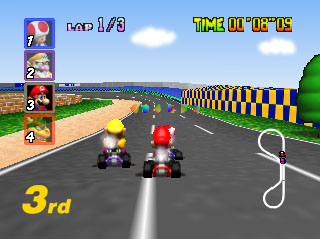
Versus Mode
In this mode, 2-4 players can race head-to-head without computer players. The screen is split into 2 halves (for 2 players) or 4 quadrants (for 3-4 players). Also in this mode, there are bob-ombs in every track of each course.
Battle Mode
In this mode, 2-4 players compete in one of four special arenas filled with item boxes. Players have three balloons attached to their kart, and lose a balloon when they are hit by a weapon, fall off the course, spin themselves out, or are spun-out from colliding with a heavier opponent. The winner is the last player with balloons left. When 3-4 players are playing, losing all 3 balloons morphs the kart into a yellow bomb. This allows the losing player to chase down a still-active opponent and exact revenge. Crashing the yellow bomb into another player costs them one balloon. The Battle Mode maps available to play on are Big Donut, Block Fort, Double Deck and Skyscraper.
Difficulty
In Mario GP, players can choose between four difficulty levels of game play. These levels are 50cc, 100cc, 150cc, and Extra.
In the higher difficulties, the top few computer-controlled drivers will usually receive large increases in speed - more than possible in a human-controlled kart - if they are trailing by a long way (e.g., if the human takes a shortcut). This will separate the pack of drivers - most computer drivers will be close, but a few will give chase to the human player. Similarly, if the human player is very far behind, then the computer drivers will all slow down and clump together to give the human time to catch up. Sometimes, one single computer player will surge way ahead of the rest of the pack, completing the entire race before anyone else. This is possibly a glitch.
Characters
- Mario
- Luigi
- Princess Peach
- Yoshi
- Toad
- Donkey Kong
- Wario (new)
- Bowser
Note: In addition to the drivers, Lakitu runs the race. His responsibilities are signaling the start of the race, notifying drivers when they complete a lap, warning those who are going in the wrong direction and rescuing racers who go "out of bounds".
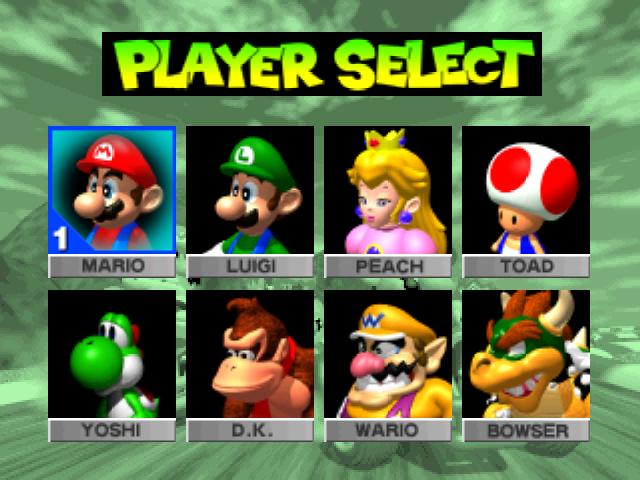
Items
Items can be acquired by hitting an item box, a rainbow-colored box with a spinning question mark. The lower one's current position, the higher his chance of getting a powerful item (i.e. Starman, Thunderbolt, etc.) As an element of balance, the best items typically only appear for the players in the worst positions.
Projectiles
- Green Shell - A simple projectile which travels in a straight line and bounces off walls.
- Triple Green Shell - Three Green Shells orbit the driver until each of them is fired away. When fired, they act as single Green Shells do. While orbiting around the player's kart, it acts as a shield that protects the player from being harmed by other projectiles.
- Red Shell - A semi-intelligent projectile. It locks onto the person one position in front of the player and attempts to crash into him or her. However, it can easily be avoided.
- Triple Red Shell - Similar to the Triple Green Shells, except they behave as Red Shells.
- Blue (Spiny) Shell - Targets the player in first place and hits anything in its way, including other racers. If a person is in first place and uses it though, the shell will target that same person who fired it in first place.
Hazards
- Banana - These can be laid on the track and caused players to spin out. The player can trail a single Banana behind him or her or he or she can throw them forward with limited accuracy. If the player drives over a Banana while driving straight, he or she can hit the brake immediately to try and stop himself or herself from spinning out (a musical note appears above the driver's head if he or she succeeded). This item is typically only used by the player in first place, and is rarely gained by players in other positions.
- Banana Bunch - A group of five bananas trail a player until they are released one by one. When released they act as normal bananas do, but while in a chain behind a player then can be used to spin out a player that is following too closely. If something touches the chain, all of the bananas will fly off in different directions.
- Fake Item Box - These resemble item boxes (the question mark is upside down "¿"), but when touched cause a driver to lose all speed and explode into the air. Like bananas, they can protect the player from incoming Red and Green Shells if held behind the kart.
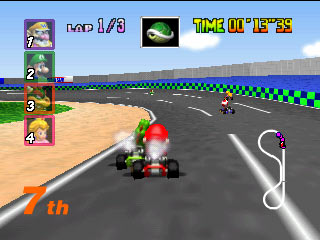
Mushrooms
- Mushroom - Increases the driver's speed for a few seconds.
- Triple Mushroom - Allows a driver to use a mushroom three times.
- Golden Mushroom - Allows a driver to use an infinite number of boosts for a short, fixed amount of time.
Miscellaneous
- Starman - Makes a player invincible to attacks and increases driving speed. If a player collides with someone with a Starman active it will cause him or her to explode into the air. Additionally, no speed is lost if the driver drives off-road while using a Starman. Driving through certain objects (such as trees) in Starman mode causes them to be blasted away.
- Boo - May steal a random weapon from another player and will make the driver invisible to other drivers for several seconds. While invisible, the player is invincible and can go through some objects such as trees and other racers, but cannot go through permanent track obstacles. If no other racers have an item, the player just turns invisible for the certain amount of time.
- Thunderbolt - Causes all other players to spin out of control and become small. As a consequence of their diminished size, players move slowly. This state lasts for several seconds during which the user can flatten other drivers by colliding with their miniature form. Also, the collision of two miniaturized drivers causes them both to be flattened and stopped completely. In addition, any major jumps, such as the one in Wario Stadium, cannot be made when small. After a miniaturized driver is flattened, or if he falls off the race course, he will be restored to his original size, regardless of whether other drivers have been restored to their original sizes. Players that are invincible via Starman and invisible via Boo are invulnerable to Thunderbolts, as are those in the middle of a boosted jump or in the midst of being fished back onto the track. Thunderbolts do not appear in Battle mode.

